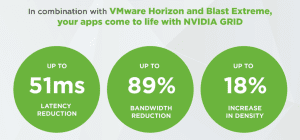IGEL Blog

A New Frontier in Virtual Desktops and Applications with VMware Blast Extreme Protocol and IGEL’s Thin and Zero Clients
 The following blog is a post developed in conjunction with the VMware End User Computing product marketing team.
The following blog is a post developed in conjunction with the VMware End User Computing product marketing team.
Optimizedvmware-blog for the modern cloud, the VMware Blast Extreme remote experience protocol supports the broadest range of client devices. It delivers an excellent user experience with low CPU consumption by fully leveraging the H.264 hardware offload engine on Thin and Zero client devices from IGEL. What’s more, the Blast Extreme display protocol can be used for both remote applications and for remote desktops that use virtual machines or shared-session desktops on an RDS host.
Deep integration with graphics technology solutions such as NVIDIA Grid enables the solution to deliver a superior experience with sharper graphics for 3D graphics applications, office applications such as Adobe Photoshop, and modern operating systems such as Windows 10 from both public and private clouds.
The Blast Extreme protocol also offers high level of enterprise security by simplifying firewall port configurations, while supporting both TCP and UDP transport protocols. This enables users to have seamless access to their desktops and applications from any device and any location – even with unpredictable network conditions.
The integration of VMware’s Blast Extreme Protocol with IGEL’s line-up of thin and zero clients is a game-changer for our customers, because it provides a level of flexibility and performance that goes well beyond what has been available previously through the endpoint platform. Some of the key advantages for customers include:
- Quick integration of new feature sets: IGEL’s Universal Managements Suite (UMS) makes it easy to centrally configure and add new features available through the VMware Blast Extreme Protocol via UMS firmware updates and UMS profile management. Additionally, new peripherals can be easily supported by adding virtual channels to the software.
- Industry-standard codecs: Through the server-based hardware acceleration available with VMware Horizon 7 and the VMware Blast Extreme Protocol, which leverages H.264 and JPEG/PNG codecs, IGEL’s thin and zero clients can provide the desktop or laptop experience that users are accustomed to when it comes to 3D graphics and video.
- Centralized management: Through the IGEL UMS, IT organizations can manage all IGEL-based and non-IGEL endpoints running the IGEL Linux-OS operating system, and a single profile in the UMS can configure any VMware Horizon endpoints operating within the infrastructure.
- Linux partitioning: Through the IGEL UMS, with a single click, IT organizations can activate only the functionality needed to run the VMware Blast Extreme Protocol, which limits the amount of active code in the system and reduces the size of the firmware. Additionally, through partitioning, all available features are pre-installed in the system with no additional software deployment required.


